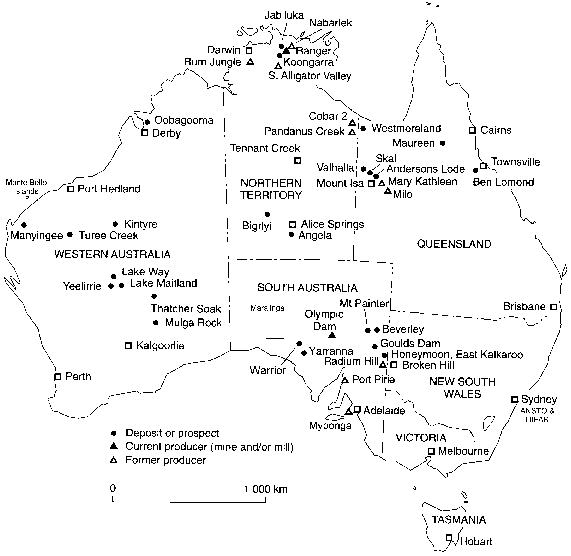DIAGRAMS AND REPORT EXTRACT
Uranium Mill Tailings Wastes in Australia : Past, Present and Future Management - Research Report Summary
Gavin M. Mudd - Environmental Hydrogeologist
P.O. Box 6405, St Lucia, QLD 4067 (G.Mudd@mailbox.uq.edu.au)
This paper is a brief summary of a 70 page research report.
Contact MAPW to order the full report. (www.mapw.au.nu)

Ranger, NT
· The large Ranger Project triggered the debate about uranium mining in the mid 1970s.
Discovered by Noranda in October 1969 on the Peko-EZ leases, the potential of the lease was quickly established by late 1970 as being of world-class. Peko-EZ acted fast to try and pre-empt the environmental impact assessment, national parks, uranium mining and Aboriginal land rights debates, but to no avail. Various government policies deferred mining lease decisions until the Ranger Uranium Environmental Inquiry was established in July 1975, reporting in October 1976 and May 1977.
· After cautious approval by the Inquiry reports, signing of an Agreement with the Northern Land Council (on behalf of the traditional owners, allegations of excessive duress still persist) and detailed design, construction finally began in 1979, opening in mid 1981.
· The Ranger Inquiry, however, was quite critical of many aspects of the Ranger Project, which subsequently forced many substantive design and management changes, including waste rock, water and tailings management and environmental monitoring.
· Experience since opening of the mine has shown that the original designs overestimated evaporation while underestimating rainfall - leading to higher volumes of contaminated mine waters to be stored on site. This in turn has led to pressure for irrigation on some areas, which have now become contaminated with salts and radionuclides. In some years, there has been enormous pressure placed on the traditional owners to approve the release of contaminated waters - which the traditional owners vetoed most strongly.
· Over the last 25 years, an increasing trend for sulfate, uranium and magnesium in Magela Creek and the heavily impacted creeks and billabongs in the Ranger project area is clear. Significant uncertainty exists as to the long term effects of these chronic exposures.
· Despite a clear and absolute recommendation from the Ranger Inquiry for final, below ground disposal of tailings, ERA spent several years trying to research ways to rehabilitate the above ground tailings dam - all research showed it would eventually fail before 1,000 years and so ERA have now accepted below ground disposal back in the mined out pits as the best approach. Several million tonnes of tailings still remain in the original dam and awaits the completion of mining of Pit #3 and the future of Jabiluka before they will be returned to the pits. Before using Pit #1, ERA did not line the pit to minimise seepage.
· The interpretation of groundwater contamination from the original tailings dam and Pit #1 is complex. Rapid seepage pathways exist (such as the Magela Fault system and fractured rock aquifers), but the chemistry is of the most importance. Salinity is migrating through groundwater, but radionuclides appear to be retarded to date, although conflicting data from the company and regulatory authorities clouds the true picture.
· It is clear that the best long-term option for Ranger tailings is for below ground tailings disposal. The potential for groundwater contamination is increased by ERA's failure to properly line Pit #1, and depending on the final configuration of Pit #3, there does not appear to be much prospect for improved management of uranium mill tailings at Ranger.
Some of the greatest concerns of the author are the standards applied to waste rock dumps and the potential for Pit #3 to be left as an open lake. The Ranger site will need to be carefully guarded for many, many decades before any degree of confidence with the management of its radioactive tailings, waste rock and mining legacy can be asserted.

